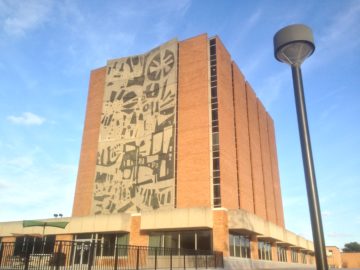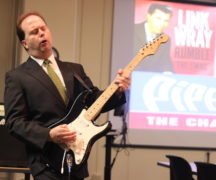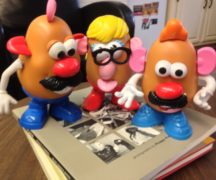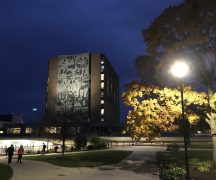By DAVID DUPONT
BG Independent News
In celebrating the largest piece of art on the Bowling Green State University campus, Jerome Library welcomed a new piece to its collection.
The wood, Plexiglas, and LED artwork by Vince Koloski pays tribute to the towering murals that decorate the east and west facing walls of Jerome Library.

Jerome Library’s west face.
As with the murals, though, what’s inside the new work is what’s important, Koloski said. From the interior unfold five panels with phrases that praise libraries and books.
“It’s a nice building,” Koloski said, “but what’s important is what’s in the building, the knowledge, the content.”
That’s what those panels represent. The quotations were collected by the other important element in his view, the librarians.
Those librarians, retired and active staff, together with the campus and Bowling Green community gathered Friday afternoon to celebrate the 50th anniversary of the dedication of Jerome Library.
Library Dean Sara Bushong said this was 50 years to the day that the ceremonies marking the dedication of the library in 1967 began. The formal dedication was held the next day on Nov. 4.
In her talk on the history of the Donald Drumm murals, Librarian Amy Fry noted that the building was not intended to have the murals. But BGSU President William T. Jerome was “keenly interested in beautifying the campus.”
To that end, Fry said, he invited Donald Drumm to serve as an artist in residence. His first project was creating a cast aluminum sculpture for the lobby of the administration building.
The original design for the university library did not have any decoration on it, so Jerome asked Drumm to design murals for the two faces. He sandblasted those onto the walls and put in stainless steel pins that protruded three inches from the face. The play of shadow and light was supposed to bring the design to life.
But, Fry said, Jerome and Drumm were disappointed with the subdued effect. So some areas of the mural were painted brown, and the artistic landmark visible from I-75 took final shape.
The work was done over the summer of 1966 and when students returned their reactions, Fry said, ranged from “fantastic” to “grotesque” and “inappropriate,” or “better than a blank wall.” One suggested shrubs would have been a better way to beautify campus.
For his part, Jerome took the reaction as a sign that the murals were doing their job to provoke a reaction.
University President Mary Ellen Mazey remembered seeing the library from the highway when she arrived. “That’s truly a unique building.” Then she made it the front page of her presentation.
Mazey also spoke of how libraries have changed. As a student she loved going venturing into the stacks. Most students now would not share that enthusiasm.
Now libraries offer much more. The first floor of Jerome has a focus on student services from the FLY Program that helps students with learning disabilities to the Collab Lab that helps them generate innovative ideas. There’s even a café. That’s a change from the days when Bushong was an undergraduate and had to sneak in M&Ms.
Mazey recalled her discussions with a previous athletic director about the location of the office of student athlete advising services.
He wanted it with the rest of the athletic department offices, but Mazey said: “No, no, no. They need to be in the library just as much as any other student.”

Libby Hertenstein and Vince Koloski unveil work of art.
Librarian Libby Hertenstein was the driving force behind commissioning the work by Koloski. She’d purchased two of his art books for the collection and felt he could create something fitting for the anniversary.
Hertenstein said when she leads tours of the library’s rare book collection, she poses the question: What is a book? Koloski work addresses that question.
Koloski said he’s loved libraries since he was child and would take home piles of books. When he first saw an image of Jerome, he was struck that it looked like five books between bookends. So he used that as his inspiration.
Hertenstein hopes that when the artwork is displayed – a case is on order – the work will cause people to reflect on books and libraries.
She gathered quotations that could be included.
One was solicited from Gary Hoppenstand, a scholar and author who received his doctorate from BGSU and serves on the University Libraries Advocate Board.
“Great libraries,” he wrote, “are the repository of our culture, our best thoughts, our hopes and our dreams. They house the written record of our condition, and they house our collective soul.”





